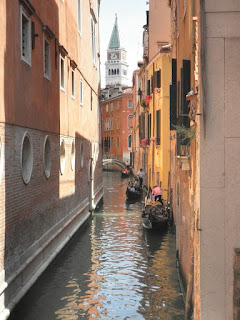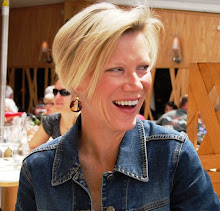
It's no wonder that Romeo & Juliet fell in love in Verona. It's easy to fall in love in Verona & easy to fall in love with Verona. It's funny how you can develop an impression about a place almost immediately. There's a feeling you get that colors your impression. For all of us (me and Mike & Maggie and Enser), we were charmed by Verona on first glance.
We drove - actually Mike drove the entire 6 hrs - from Cotignac to Verona & found our hotel without difficulty. We walked to dinner that night & discovered lively, bustling streets full of wonderful shops - some of the best I've seen. Pale stone-like colors & periwinkle blue shutters of France gave way to warm ocher & deep oranges with dark green shutters in Italy. The boulangeries are now pasta shops. Everyone is fashionably dressed. And there is a gelato shop every few feet. Like France, there is no shortage of cute sidewalk restaurants or cafes. We found one for dinner & had a lovely meal with good olive oil & excellent wine.

As we walked back to the hotel we glimpsed the edge of the Roman arena thru the narrow corridor of our street. The arena was lit against the night sky and we could not resist its pull. As we emerged from the little street we found ourselves in a large piazza that encircled the arena. Around the piazza were brightly colored buildings with restaurants glittering in the night. It was a mesmerizing sight and capped by the near full moon overhead. As we strolled around the piazza we found pieces of the set for the upcoming operas. They were stacked outside waiting to be lifted by crane into the arena. It was a magical start to our visit.
The next day was beautiful & I started it with a walk around the perimeter of the old city following the river's edge. Steeples & towers litter the skyline of Verona - giving it more charm. I walked by palazzos of red & cream stone, churches with towering white marble steeples, & river front homes with red geraniums spilling over balconies. Lovely.

We spent the day shopping. At each store I promised it would be my last purchase – and at each store I broke my promise! Many shopping bags later we met Maggie & Enser for lunch in a charming alleyway cafe. The shopping was so good that it was difficult to focus on history. Luckily you literally walk through history in Verona. We strolled under an ancient Roman arch, past an old fortress, Castelvecchio, with a moat and a three arch bridge across the river.

The bridge across the river and the towers of Castelvecchio were like walking back into an era of knights and damsels. All that walking and shopping left us with tired feet. And no trip to Verona would be complete without a visit to Juliet’s balcony.


Shakespeare's play is never far from your mind here. They have taken full advantage of its tourist potential. The first clue that you are near to Juliet’s balcony is the entrance corridor that is completely covered with love notes from all over the world. We were told that you can write a letter to Juliet requesting romantic advice and a cadre of volunteers answers the letters. The balcony, situated in a pretty little courtyard, is like a storybook. It looks just as you would expect – an image that is helped along by the movies filmed here. I had the chance to see Juliet’s balcony during my walk when I was the only one there.

When Mike & I returned I couldn't believe the crowds of people packed into this tiny space - all for a fictional character. Clearly, Juliet or, more likely, the idea of romance resonates with people of all ages and backgrounds. After a bus ride around the city it was time for a nap & preparing for the main event - Aida.

Aida and other operas are performed in the old Roman arena. The arena seats about 20,000. The general admissions seats are on the original marble stadium seats. Thankfully, we had reserved seats in cushioned chairs on the floor a few rows from the stage. The performance is open air & is immediately cancelled in the event of rain. If the performance starts before the rain hits there are no refunds. We held our breath & sent out good thoughts for a clear night (weather forecasts were iffy) & we got it. It was perfect- warm, a slight breeze, & dry.

It's hard to describe the thrill of walking into this first century arena. Our entrance was through thick, rich, red curtains and on a red carpet. It was moment I won't forget. Maggie & I were almost giddy with excitement. How fortunate we are to have the opportunity to be in Verona, Italy at a performance like this. We had fabulous seats, close enough to watch the conductor wave at the musicians and feel him stomp his feet during dramatic parts. The stage was set with huge props. The centerpiece was a large, gold pyramid that rotated for scene changes. Opera clearly transcends countries and we heard excited voices in languages from around the world as people milled about before the start. Everyone was dressed up for a special evening. And we weren't disappointed.

Neither Mike nor I are opera buffs and still we were moved by the music & grandeur of the production. The arena is the largest opera venue in the world & serious connoisseurs attend regularly. The costumes were elaborate & the cast numbered more than one hundred. When the full chorus sang they filled the arena with rich, deep sound. The soloists, too, with no microphones filled up the space with sound & emotion. You felt Aida's sadness & grief through her singing. Of course, the triumphal march was - triumphal.
As the performers sang their arias there was one particular audience member who would shout “bravo!” after a notable performance. He knew his stuff. At the end of the opera he summed up the experience with a shout heard throughout the arena – “Viva Verdi!”

One of the wonderful things about Italy is the close proximity to many wonderful towns. In this case, we were an hour train ride to Venice. Who could resist that? We journeyed over the next morning and spent part of the day wandering the streets of Venice and browsing shops, sipping coffee and tea, and nibbling on little sweets. All of us had been to Venice before – in the off season – and were taken by surprise by the crowds there on a beautiful Saturday in June. We weren’t thinking very clearly! But, still, Venice is captivating. The only disappointment was the prevalence of huge advertising billboards placed over many of the major attractions. We were horrified to see all sides (left, right, above and below) of the Bridge of Signs covered with huge adds. I can’t imagine the costs of maintaining all these beautiful buildings in such a difficult environment. The advertising income is probably a big help, but I couldn’t help but feel they’d taken it too far. It felt like part of the soul of Venice had been sold.
(left, right, above, and below) of the Bridge of Sighs covered with advertisements.

It's been great to share our experience in Verona and at the opera with Maggie and Enser. And our adventures didn't stop there. We left for Lake Como this morning but not before I got in one more beautiful walk around the city alongside the river. It is truly a lovely place. As I walked, there came a strong whiff of something sweet and somehow familiar in the air. I was under a row of magnolia trees with blooms open to the sun. The fragrance took me to Texas – home.

Before we left for Verona, we took a day trip thru the lavender fields just north of Cotignac. On our way we stopped at one of the better wineries in the area. Between us we bought a box of wine. Enser said he felt like Bacchus! It is almost peak time for lavender & the harvest starts in mid July. We had no idea what to expect & were thrilled with our first sight of a lavender field - row after row of mounded lavender plants. With the windows down, we could smell their fragrance as we drove. Purple alternated with the pale, straw color of wheat fields. One of our discoveries was amazing lavender ice cream in Riez – we will be back!

We spent so much time in the lavender shops in Valensole that we missed our window for lunch. It was a Monday & few places were open. We found a restaurant that agreed to serve us if we'd all eat their special - lasagna. “Yes” was the only answer. It turned out to be good & we enjoyed sitting outside on a lovely day. The unexpected surprise was that our waiter who also seemed to run the restaurant was wearing a Waldorf t-shirt!

Yes - Waldorf, MD. What are the odds? He said the shirt was not his and he had no idea were Waldorf was. He was surprised at our incredulous reactions but he was more than happy to pose for a photo with me and Maggie!
We finished our drive thru Moustiers, a lovely town wedged into the cliffs of the Verdon. There is a large bridge that spans the gorge & we stopped for one final photo - or so we thought. Just as we began to get back in the car to go home we heard all this racket- clanging & rattling. Mike said it sounded like a tiki bar. I looked over the bridge & thought I saw a peloton of cyclists headed our way. But no! It was a herd of sheep & goats, many with bells around their necks. There were a few people walking with them but they were being managed & herded by a small black & white sheep dog. We were transfixed - first by seeing sheep walking down a main road & second by this dog. He was one hardworking little guy! And his job got worse when the herd cleared the bridge & the sheep tried to wander up the hillside. He kept them in line!

Before I go and enjoy the amazing scenery of Lake Como, I offer one final reflection. We frequently hear remarks about our “vacation,” and I hear myself describe it as a “grand vacances” lacking any other term. But each time I pause. Somehow being in France doesn't feel like a vacation - but why not? After pondering it for awhile I think I've hit on it. We relocated our lives to France and don’t view ourselves as visitors or tourists. We live here. We make an effort to attend village events & meet people in the shops - hardware, bakery, ice cream, restaurants & vineyards. We want to be participants in life here. We're learning our favorite farmers at the markets & recognize the regulars at the various bars. It feels different from when we are tourists, seeing the sights, having an experience, buying souvenirs & returning home. We've done some of that since we’ve been here but we feel more like residents now than visitors. And that’s just the way we want it to be.




































